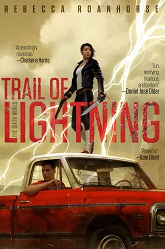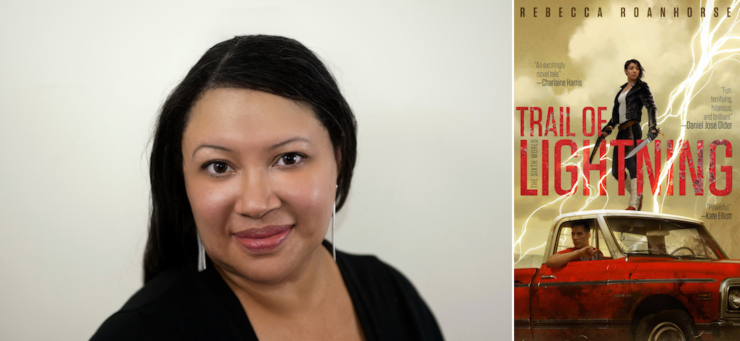When the cover for Rebecca Roanhorse’s debut novel Trail of Lightning was first revealed, the Nebula Award-winning author emphasized how she hadn’t wanted Dinétah monster hunter Maggie Hoskie to be depicted in “the typical trappings non-Natives associate with Native Americans” such as feathers or braids. Yet she still wanted Maggie to be recognizably Navajo, which is why she wears traditional Navajo women’s moccasins alongside her leather jacket and knife.
A similar discussion came out of Roanhorse’s recent Reddit AMA (Ask Me Anything) on r/fantasy, in which the author of the award-winning short story “Welcome to Your Authentic Indian Experience™” explained which aspects of Diné culture she incorporated as Easter eggs, and which were off-limits. It makes for fascinating insights into an already engaging novel that kicks off a new rural fantasy series.
Redditor TerribleReturn asked:
I still haven’t read Trail of Lightning yet, but reading the interviews you’ve done in the lead up to its release has made me curious about your process for deciding which parts of Diné culture to include, which to make up, and which that were completely off-limits for the page. I’m sure that having Diné friends, family, and elders within reach throughout your writing of the book helped a lot, but was there ever a point where you felt in over your head, and if so, how did you ultimately deal with that? And do you think there were any aspects of your own Black/Pueblo heritage that bled into the worldbuilding or characters as well?
Roanhorse responded:
My goal with the book re: Diné culture, was accuracy and respect. The Navajo Nation is like my second home. I lived there fulltime for a few years, but over the last decade have traveled back regularly for weekends, family celebrations, etc. I love the place and the people and I wanted to share some of that love and hopefully give Navajo readers a chance to see themselves accurately portrayed and centered in Fantasy. There are so many Easter eggs in the book if you’re from the Window Rock/Gallup area, and I put those in for Navajo readers to enjoy and laugh at. Something off limits was ceremony. I didn’t include anything that one might experience in ceremony directly. And yes, I’m a fiction writer, a fantasy writer at that, so I made a lot of stuff up! Clan powers, for example. Completely a fiction. I also chose to focus on traditional stories (mythology) that is out there already in comic books and other SFF, mostly but not all by Navajo creators like Dale Ray DeForest—a favorite comic book artist of mine. I didn’t want to be the only one working with Navajo stories. And I’m sure my own heritage impacts everything I write. Remember, the only non-Navajo characters in the book are a Black family, the Goodacres, who will continue to play a big role in future books. And in Book 3, we come to The Burque, where you will undoubtedly see some Pueblo influence.
Later in the thread, Redditor booklover912 delved into specific moments tying the rural fantasy of Trail of Lightning to present day:
Even-though your novel is a urban/rural fantasy you’ve included heavy themes that are very prominent and real to Native American Women and Native Americans in general. Was their ever a moment during the writing process that you considered backing away from such topics (police brutality, abuse, kidnap/ missing person, ect) and if so what gave you the courage to take such a strong stance?
You said in an interview that you didn’t see the society in which you built as a dystonia/ dark world but instead a renaissance: How did you find the balance between creating a Navajo society full of strength while also creating an apocalyptic world?
Buy the Book


Trail of Lightning
Roanhorse matched their thoughtful questions with equally insightful answers:
I am so pleased that you noticed the contemporary issues I wove into the story, the biggest one for me being mental health, abuse and trauma, issues very prominent and important in the Native community, particularly for Native women. I think sometimes SFF allows the writer to talk about these things in a way that maybe wouldn’t work, or at least works differently, in literary fiction or non-fiction. It may seem frivolous for my characters to derive their superpowers from trauma, but, as Reddit user theheroellipsis astutely comments upthread, I’m saying something about being a survivor that doesn’t (hopefully) just become backstory or the typical “hero with a troubled past”. I want my characters to wrestle with their pasts, and not always win. I’m more afraid of writing milquetoast than I am of writing heavy themes. But also, I want to balance the heavy with fun. I think you can read TRAIL as just a fun adventure story, or you can see the deeper layers. It’s up to the reader.
re: balance. I just looked around me. That is the Native experience. I’m going to obnoxiously quote myself (forgive me—it’s 12:41 am here and I need to go to bed) but I wrote about this in an essay for Uncanny Magazine:
“To be a Native of North America is to exist in a space where the past and the future mix in a delicate swirl of the here-and-now. We stand with one foot always in the darkness that ended our world, and the other in a hope for our future as Indigenous people. It is from this apocalyptic in-between that the Indigenous voices in speculative fiction speak.”
Check out the rest of Roanhorse’s AMA for her unofficial Trail of Lightning soundtrack, Star Wars love, and her recommendation for the best greasy green chile cheeseburger in New Mexico. And next week you’ll be able to listen to LeVar Burton read “Welcome to Your Authentic Indian Experience™” on his podcast LeVar Burton Reads!










